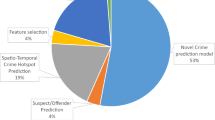Abstract
Crime is canonically “capricious”. It is not necessarily hap-hazardous, but neither does it occur consistently. A better theoretical perception is needed to facilitate practical crime prevention solutions that correspond to specific places and times. Crime analysis and prevention is a systematic approach for identifying and analyzing patterns and trends in crime. Crime data analysts helps in law enforcement officers to speed up the process of solving crimes, owing to increase in the advent of computerized systems. This research is an attempt to forecast the occurrences of crimes, and predicts the frequency (count) of crimes at beat-day level in the city of Chicago. Forecasting crimes helps in taking care of crime prevention methods and the frequency of crimes helps to focus on the type of crime. This novel work is a collaboration between computer science and criminal justice aimed to develop a data mining procedure that can help solve crimes faster. Instead of focusing on causes of crime occurrence like political enmity, the criminal background of the offender etc. the author focused on crime factors for each day.











Similar content being viewed by others
References
Han, J., Pei, J., & Kamber, M. (2011). Data mining: Concepts and techniques. Amsterdam: Elsevier.
Dunham, M. H. (2006). Data mining: Introductory and advanced topics. India: Pearson Education.
Osborne, D., & Wernicke, S. (2003). Introduction to crime analysis: Basic resources for criminal justice practice. New York: Psychology Press.
Paulsen, D. J., Bair, S., & Helms, D. (2009). Tactical crime analysis: Research and investigation. Boca Raton: CRC Press.
Zubi, Z. S. (2009). Using some web content mining techniques for Arabic text classification. In Proceedings of the 8th WSEAS international conference on data networks, communications, computers, Stevens Point, Wisconsin, USA (pp. 73–84). Citeseer: World Scientific and Engineering Academy and Society.
Brown, D. E., & Hagen, S. (2003). Data association methods with applications to law enforcement. Decision Support Systems, 34(4), 369378.
Lin, S., & Brown, D. E. (2006). An outlier-based data association method for linking criminal incidents. Decision Support Systems, 41(3), 604615.
Icove, D. J. (1986). Automated crime proling. FBI Law Enforcement Bulletin, 55, 27.
Corcoran, J. J., Wilson, I. D., & Ware, J. A. (2003). Predicting the geo-temporal variations of crime and disorder. International Journal of Forecasting, 19(4), 623634.
Ozkan, K. (2004). Managing data mining at digital crime investigation. Forensic Science International, 146, S37S38.
Wang, T., Rudin, C., Wagner, D., & Sevieri, R. (2013). Learning to detect patterns of crime. In Joint European conference on machine learning and knowledge discovery in databases (pp. 515–530). Berlin: Springer.
Short, M. B., Dorsogna, M. R., Pasour, V. B., Tita, G. E., Brantingham, P. J., Bertozzi, A. L., et al. (2008). A statistical model of criminal behavior. Mathematical Models and Methods in Applied Sciences, 18(supp01), 12491267.
Ratclie, J. H. (2006). A temporal constraint theory to explain opportunity-based spatial offending patterns. Journal of Research in Crime and Delinquency, 43(3), 261291.
Toole, J. L., Eagle, N., & Plotkin, J. B. (2011). Spatiotemporal correlations in criminal oense records. ACM Transactions on Intelligent Systems and Technology (TIST), 2(4), 38.
Buczak, A. L., & Giord, C. M. (2010). Fuzzy association rule mining for community crime pattern discovery. In ACM SIGKDD workshop on intelligence and security informatics (p. 2). ACM.
Chainey, S., Tompson, L., & Uhlig, S. (2008). The utility of hotspot mapping for predicting spatial patterns of crime. Security Journal, 21(1–2), 428.
Eck, J., Chainey, S., Cameron, J., & Wilson, R. (2005). Mapping crime: Understanding hotspots (pp. 1–71).
Mohler, G. O., Short, M. B., Brantingham, P. J., Schoenberg, F. P., & Tita, G. E. (2011). Selfexciting point process modeling of crime. Journal of the American Statistical Association, 106(493), 100108.
Tumasjan, A., Sprenger, T. O., Sandner, P. G., & Welpe, I. M. (2010). Predicting elections with twitter: What 140 characters reveal about political sentiment. ICWSM, 10(1), 178185.
Bollen, J., Mao, H., & Zeng, X. (2011). Twitter mood predicts the stock market. Journal of Computational Science, 2(1), 18.
Wang, X., Gerber, M. S., & Brown, D. E. (2012). Automatic crime prediction using events extracted from twitter posts. In International conference on social computing, behavioral-cultural modeling, and prediction (pp. 231–238). Berlin: Springer.
Police, C. Chicago Data Portal. https://data.cityofchicago.org/
Author information
Authors and Affiliations
Corresponding author
Additional information
Publisher's Note
Springer Nature remains neutral with regard to jurisdictional claims in published maps and institutional affiliations.
Rights and permissions
About this article
Cite this article
Shukla, S., Jain, P.K., Babu, C.R. et al. A Multivariate Regression Model for Identifying, Analyzing and Predicting Crimes. Wireless Pers Commun 113, 2447–2461 (2020). https://doi.org/10.1007/s11277-020-07335-w
Published:
Issue Date:
DOI: https://doi.org/10.1007/s11277-020-07335-w




